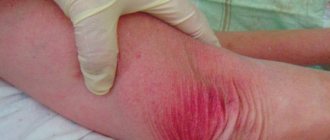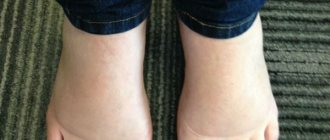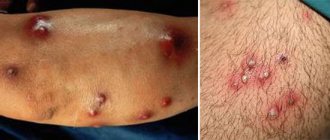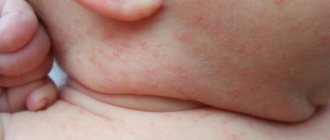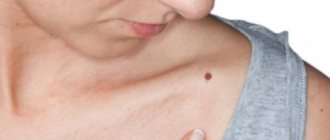Home Articles Prevention and treatment of bedsores
Prevention and treatment of bedsores is an integral part of home or hospital care for bedridden patients. For a person bedridden, bedsores become not just a source of discomfort, but a potential threat of the formation of a primary source of sepsis. To prevent complications, the patient’s relatives need to equip themselves with special knowledge on the care and prevention of bedsores, or hire a specialist, for example, a nurse from a patronage service.
Definition
Bedsore
(ulcer, pressure injury, pressure ulcer, decubitus ulcer, bedsore) – local damage to the skin and (or) underlying tissues. Bedsores are formed as a result of pressure or a combination of pressure with other damaging factors (friction, shear, humidity and others). They are located, as a rule, over bony prominences (sacrum, heels, ankles, fingers, elbows, sit bones, spinous processes of the spine, coccyx, hip joints and the back of the head).
Weakened bedridden and sedentary patients with impaired blood circulation, sensitivity (strokes, spinal cord injuries) and concomitant diseases most often suffer from this problem. A significant role in the occurrence and development of local damage to the skin and underlying tissues is played by improper care, urinary and fecal incontinence. Bedsores are a very unpleasant, dangerous and expensive complication that worsens the quality of life, the patient’s condition and prognosis, slows down the treatment process, and requires additional care, medical supervision and expenses. This complication must be kept under control.
Bedsore photo
Consequences and complications
Bedsores often lead to the appearance of wounds and their subsequent infection. This, in turn, will prevent wounds from healing.
osteomyelitis may develop . In rare cases, squamous cell carcinoma may develop within the ulcer. Fistula tracts, cellulitis, and soft tissue calcification may also form. Bacteremia , meningitis and endocarditis are possible complications .
If serious complications occur, death from bedsores is likely. If left untreated, such a death can be very painful.
Classification. Stages. Categories
Bedsores are divided into stages (categories)
There are four main stages (categories). And two additional stages (categories). The classification is proposed by the European Advisory Panel (EPUAP) and the American National Pressure Ulcer Advisory Panel (NPUAP). Stages and categories are necessary to understand the severity, depth of tissue damage and make treatment decisions. They help you decide and answer questions. How to carry out treatment and care? When is surgery necessary? Which bandages to choose? Forecast?
Bedsores are often difficult to diagnose. Sometimes it is very difficult to distinguish them from dermatitis or diaper rash. It is very important to correctly understand and establish a diagnosis, since prevention, treatment and care regimens may differ.
Diaper rash photo
Stage (category) 1
Redness (hyperemia, erythema) is persistent, does not go away and does not fade when the pressure is removed. The redness is local and located above the bony prominence. Sometimes it is not very noticeable. The area suspected of developing a bedsore may be a different color and different from the surrounding tissue (ashy, bluish or purple). Stage (category) 1 initial - this is a signal that a bedridden patient is already at risk for the formation of deeper, more extensive and severe bedsores!
Bedsore 1st (initial) stage photo
Stage (category) 2
Damage to the surface layers of the skin (epidermis and dermis). A bedsore looks like a shallow open wound, ulcer, erosion with a red or pink bottom. There may be a superficial scab (crust) or fibrin deposits. At this stage, changes can be in the form of a bubble, which is filled with serous or sanguineous contents. Sometimes this bubble ruptures in the form of exfoliated and wrinkled epidermis (the surface layer of the skin).
Bedsore stage 2 photo
Stage (category) 3
At this stage, damage (necrosis-death) of all layers of the skin occurs. Subcutaneous fatty tissue is visible in the wound. The bones, tendons and muscles are covered, not exposed. There may be scab (crust) or necrosis (dead tissue) on top. The edges of the wound are undermined. There may be pockets, streaks with purulent discharge and fistula tracts.
Bedsore stage 3 photo
Stage (category) 4
Tissue damage (necrosis - necrosis) of all layers of skin and subcutaneous tissue. Unlike the third stage, deep-lying tissues and structures (fascia, tendons, muscles, bones and joints) are damaged and subject to a purulent-necrotic (suppuration and necrosis) process. Blood circulation in the affected area is impaired. The wound is partially or completely covered with necrotic mass (dead tissue) or scab. Deep pockets, streaks with purulent discharge and fistulous tracts are characteristic of this stage. Wet necrosis (dead tissue) of a bedsore can cause intoxication and sepsis. Bone structures and joint capsules may gape in the wound, which makes osteomyelitis possible. Osteomyelitis is a severe complication (suppuration, necrosis and sequestration-rejection of bone tissue).
Bedsore stage 4 photo
Stage (category): unclassified pressure ulcer
Deep necrosis (death) of tissue in which the bottom of the wound may be covered with plaque (yellow, yellow-brown, grey, green, brown or black) and/or a scab-crust (brown or black). Before removing necrosis (dead tissue) and/or plaque, it is impossible to accurately classify a bedsore; after removal, as a rule, 3-4 stages are identified.
Stage (category) unclassified bedsore photo
Stage (category): suspected deep tissue damage
A local focus of tissue damage of a dark color (purple or burgundy) with clear boundaries against the background of normal, unchanged skin. It may be in the form of a dark hematoma (bleeding) due to damage to soft tissues as a result of their compression and/or displacement.
Stage (category) suspicion of deep tissue damage photo
What medications are used
The choice of treatment for pressure sores on the tailbone varies depending on the extent of the lesion and the severity of the disease. The doctor may recommend antiseptics, wound healing agents, and drugs that improve blood circulation. Chlorhexidine or another antiseptic solution is used to treat the skin, but not in every case it is possible to treat an open wound.
The classic approach to treatment includes several stages:
- Disinfection and cleaning of tissues in and around the damaged area.
- Applying a special cream or ointment dressing that promotes the rejection of dead cells.
- The use of agents that prevent bacterial infection (antiseptic dressings, etc.).
- If a bacterial infection is detected, the doctor will prescribe antibiotics. For inflammation - anti-inflammatory drugs. For pain - analgesics.
- Application of wound healing agents in the form of ointment dressings and creams.
It is not recommended to treat bedsores on the buttocks without consulting a doctor.
Prevention of bedsores
It is easier and cheaper to prevent bedsores than to treat and care for them!
Bedsores are primarily a care problem. If everything is properly organized, the risk of the occurrence and spread of ulcers is significantly reduced. Before starting treatment, it is necessary to resolve the issue of organizing prevention and care for the patient.
Five principles of prevention:
- Removing pressure (functional bed, anti-bedsore mattress, inflatable rings, changing body position, every 2 hours)
- Hygiene. Constant, regular and proper care (skin care, especially in areas of increased risk of bedsores)
- Organization of daily routine and nutrition (procedures, dressings, time and diet of feeding)
- Activation of the patient (sitting down, breathing exercises, physical therapy)
- Doctor consultations and medical staff supervision
Diet
Diet for skin diseases
- Efficacy: therapeutic effect after a month
- Time frame: three months or more
- Cost of products: 1400-1500 rubles per week
To prevent the occurrence of such lesions, it is important to introduce a sufficient amount of protein products into the patient’s diet. You should choose dietary, low-fat foods - milk, eggs, lean meat, fish. You should also introduce into the diet foods containing vitamins A , C , and group B. It is recommended that such patients prepare dishes from the liver, heart, rice, and buckwheat.
It is imperative to plan the patient’s diet - he should receive food in small portions 4-6 times a day. Drinking regimen is also important - the patient needs to drink enough liquid.
Treatment of bedsores. Bedsore Care
Proper care is the basis and key to successful treatment of bedsores!
You must be prepared for the fact that the cleansing and healing of a bedsore can take many weeks, many months and even years. Very often it seems that bedsores are a hopeless and practically insoluble problem. But that's not true. Yes, its solution requires a lot of mental, physical and material costs. Yes. This is hard. But, we are able to provide, if not a complete cure, then good care and a normal quality of life for a bedridden person with bedsores. Any person deserves this. Each of us needs attention, care and love, especially in such a difficult situation. The most important thing is patience, knowledge and action.
Unfortunately, there is no universal treatment regimen, remedy or bandage for everyone. Bedsores are all different. They are in different stages and phases of the wound process. They have different sizes. Each bedridden patient has his own age, individual general condition and concomitant pathology. There is no panacea for bedsores.
But there are many modern care, treatment and dressing products, the individual combination of which can help cope with the problem. Their correct use requires knowledge and qualified or specialized medical care. In order to help a loved one, you need to go through this long and difficult path with him, step by step. It is difficult to immediately create ideal conditions, error-free care and solve all problems at once when prevention and treatment are carried out at home. Daily systematic efforts and activities under the supervision of a physician are required to improve the process of care, prevention and treatment. This will help clean and heal existing bedsores and prevent new ones from appearing. The most important criterion for proper care and treatment is the desire to provide the kind of help that we would like to receive ourselves...
Please do not self-medicate!
If there is no proper medical supervision, severe complications (cellulitis, osteomyelitis, sepsis and death) are possible. For proper treatment and care, it is necessary to have a doctor monitor the cleansing of the wound and its healing. The doctor should examine the patient, assess the condition of the patient and the wound at least once a week. It must be borne in mind that if cleansing and healing does not occur as expected, then it may be necessary to change the treatment regimen, decide on surgery and change the dressings. These critical decisions must be made by a physician. The costs, losses, complications, dissatisfaction and harm of inappropriate self-medication can be quite serious and distressing.
It is very important to organize the following activities under the supervision of a doctor:
- Prevention (5 principles for preventing bedsores)
- Prescriptions and monitoring of therapy (drugs, antibiotics and other medicines)
- Analysis, elimination and control of factors that interfere with the cleansing and healing of bedsores
- Organization of dressings (use of gloves, clean sterile instruments and (or) disposable dressing kits)
- Cleansing the wound and removing necrosis (dead tissue). Sanitation (washing the wound)
- Skin care in the wound area. Wound care. Wet wound therapy (modern dressings, vacuum therapy NPWT and VAC-therapy)
- Monitoring of complications (observation, early detection, treatment and timely hospitalization)
- Plastic interventions to close wounds after cleansing
In the first stage
there is no need for surgical aid. It is very important to focus on preventing further development of the process and the occurrence of new local damage. The main task is to protect the altered skin from pressure, exposure to damaging factors and infection. Care for stage 1 bedsores is performed using modern products for nourishing, toning and protecting the skin. The affected areas can then be covered with clear, breathable polyurethane films or hydrocolloid dressings for prevention.
In the second stage
there is a need to consult a surgeon and organize the dressing process. The surgeon removes or cuts away the detached epidermis (surface layer of skin). The wound or erosion is then cleaned and sanitized (washed). Modern innovative, interactive dressings can be used to clean, heal and care for the wound at this stage. Dressings are selected based on the phase of the wound process, wound condition, quality and level of exudation.
In the most severe third and fourth stages
A complete, high-quality surgical manual is required. Necrosis (dead tissue) of the skin, subcutaneous tissue, muscles and bone structures, which have begun to separate from living tissue and be rejected, is preferably removed surgically. Removing wet necrotic (dead) tissue, opening purulent leaks and cavities allows you to quickly clear a bedsore and reduce intoxication.
Surgical assistance significantly speeds up the process of cleansing and then healing of the wound. Skilled radical surgical treatment is preferred. But it is very important to remember that complete excision of all dead tissue during surgical treatment is not always possible or advisable. When trying to remove dead (necrotic) tissue in deep bedsores as radically as possible, heavy bleeding is possible!
To completely cleanse wounds, you can use water-soluble ointments (Levosin, Levomekol), enzymes (Proteox T, Proteox TM, PAM-T, PAM-TL, Trypsin, Chymotrypsin, Iruksol) and modern innovative dressings (HydroClean - Hydrocline, Sorbalgon - Sorbalgon , Hydrosorb Gel - Hydrosorb Gel, Atrauman Ag - Atravman Ag with silver).
After surgical removal or excision of necrotic (dead) tissue and cleansing, the main task is proper wound care (creating a moist physiological environment, absorbing secretions and preventing drying). During the granulation and epithalization phases of the wound, you can use means that accelerate healing (vinyline, Actovegin) and modern dressings (Hydrocoll, Branolind N, Hydrotull, HydroTac and others).
Also, to speed up wound healing and evacuate heavy exudate, you can use modern innovative treatment methods, such as vacuum therapy (NPWT or VAC-therapy).
If the wound does not heal on its own after cleansing and dressing for a long time, then it can be closed with the help of plastic interventions.
Tests and diagnostics
The doctor makes a diagnosis based on the symptoms that the patient has. A purulent surgeon, traumatologist or other specialist conducts an external examination of the patient, interviewing him or relatives caring for the patient. A smear from the wound and a laboratory blood test are also taken and laboratory tested. No special diagnostic methods are required. In some cases, a differential diagnosis of a bedsore with skin cancer is carried out; a biopsy .
Reviews
Anna
I would like to express my deep gratitude to Alexander for his professionalism, responsiveness and concern for patients and their relatives, which, unfortunately, is not typical of modern doctors. Alexander promptly came to my mother’s home for a consultation on the treatment of a bedsore, which we tried to cope with for 3 months, involving different doctors. Before this, the healing process was very slow with varying success. Alexander arrived with all the necessary sterile instruments and means for treatment, told and showed how to properly care for a bedsore. He even left the tools and processing equipment so that we had the opportunity, without interrupting the treatment, to order and buy everything we needed. After that, if necessary, he adjusted our treatment. Together with Alexander we dealt with this pain! I will definitely recommend this wonderful doctor! Thank you, Alexander!
Yablonin Boris
Dear Alexander Shadzhievich! I would like to express my sincere gratitude to you for your help. It's hard to overestimate her. From the moment of your first dressing, there was hope that something could be done with such a severe wound. A very important point was the dressing technique, building a wound care system, and the thoroughness and systematic implementation of all subsequent actions. Deep professional knowledge of the processes occurring in the wound, which are noticeable only to a doctor with your experience and knowledge, and most importantly the ability to communicate with a sick person. It helped me a lot that you systematically and consistently explained to me every day what processes occur in the wound, how they manifest themselves and how they can occur. Rarely do any doctors devote such filming specifically to transferring their knowledge to those who must continue caring for the wound at the stage of further rehabilitation. Without seeing the dressing technique with your own eyes, without trying to do it yourself, using your technique with new dressing materials, it would be impossible to continue caring for the wound yourself. It is not surprising that with such treatment, even I was able to see and adopt your thoroughness, attention to the smallest changes in the wound, consistency and commitment to all the small details of your technique. Separately, I simply must thank you for the psychological help that you provided to both me and my sick mother, simultaneously with the treatment of the wound itself. This help allowed me to believe in the possibility of recovery and not give up halfway through this very difficult and lengthy process. Your ability to communicate with the patient and his environment calmly, kindly, without false optimism, and very patiently was a huge moral support for me, instilling faith in the possibility of my mother’s recovery. With a feeling of sincere gratitude and appreciation for the assistance provided.
Shamsutdinova Olesya
I, Olesya Shamsutdinova, am eternally grateful to the surgeon Alexander Shadzhievich for a qualified operation (removal of necrosis) on my mother. For his sensitivity, professionalism and desire to endure, understand, hope... because together it is easier to endure sorrow. Low bow to you.
Irina
In the summer of 2022, we were faced with a very unpleasant and scary problem. Due to a long stay in the hospital and the inability to move due to a broken leg, a bedsore developed on the back (in the lumbar region). In the hospital, unfortunately, it was neglected and at the time of discharge it was assessed at grade 4 severity. Friends advised me to see a doctor, surgeon Alexander Shadzhievich Garmaev. And I want to say that we didn’t regret it for a second. Alexander arrived on the same day, performed all the necessary procedures on the wound, and observed him for several days in a row. The doctor showed how to properly treat the wound and apply bandages. The problem was solved quite quickly thanks to well-chosen treatment and modern drugs. Alexander, thank you for your professionalism, for always being in touch and coming when necessary. The psychological support of the patient and family was invaluable.
Boris
Tatiana
Andrey
List of sources
- Vorobyov A.A., Tsurikov Yu.M., Poroisky S.V. Treatment of bedsores in spinal patients // Bulletin of the Volgograd Scientific Center of the Russian Academy of Medical Sciences. - 2007.- No. 2. - pp. 33-34.
- Klimiashvili A.D. Prevention and treatment of bedsores. // Russian medical journal. - 2004. - T. 12, No. 12. — P. 40-45.
- Paukov V.S., Musalatov H.A., Saltykov B.B., Shashlov S.V. Ermakova N.G., Elizarov M.N. Immunomorphological characteristics of bedsores // Pathology Archives. 1997. - No. 6. — p.40-44.
- Prevention and treatment of bedsores. Association of General Practitioners (Family Doctors). - M., 2004. - P. 44-64.
Folk remedies
Only bedsores of the first and second stages can be treated well at home. To do this, you must strictly follow the recommendations of a doctor who knows how to treat bedsores effectively and safely. You should not resort to recipes and methods of traditional medicine, which can only aggravate the situation.
To successfully combat pressure sores on the buttocks, use modern, proven means, such as effective dressings with Peruvian balsam “Branolind N” or HydroClean Plus. It is strictly forbidden to treat bedsore areas with brilliant green, hydrogen peroxide, or iodine, as they promote tissue necrosis.
Treatment should be aimed at restoring blood circulation at the site of the lesion and reducing external pressure.

